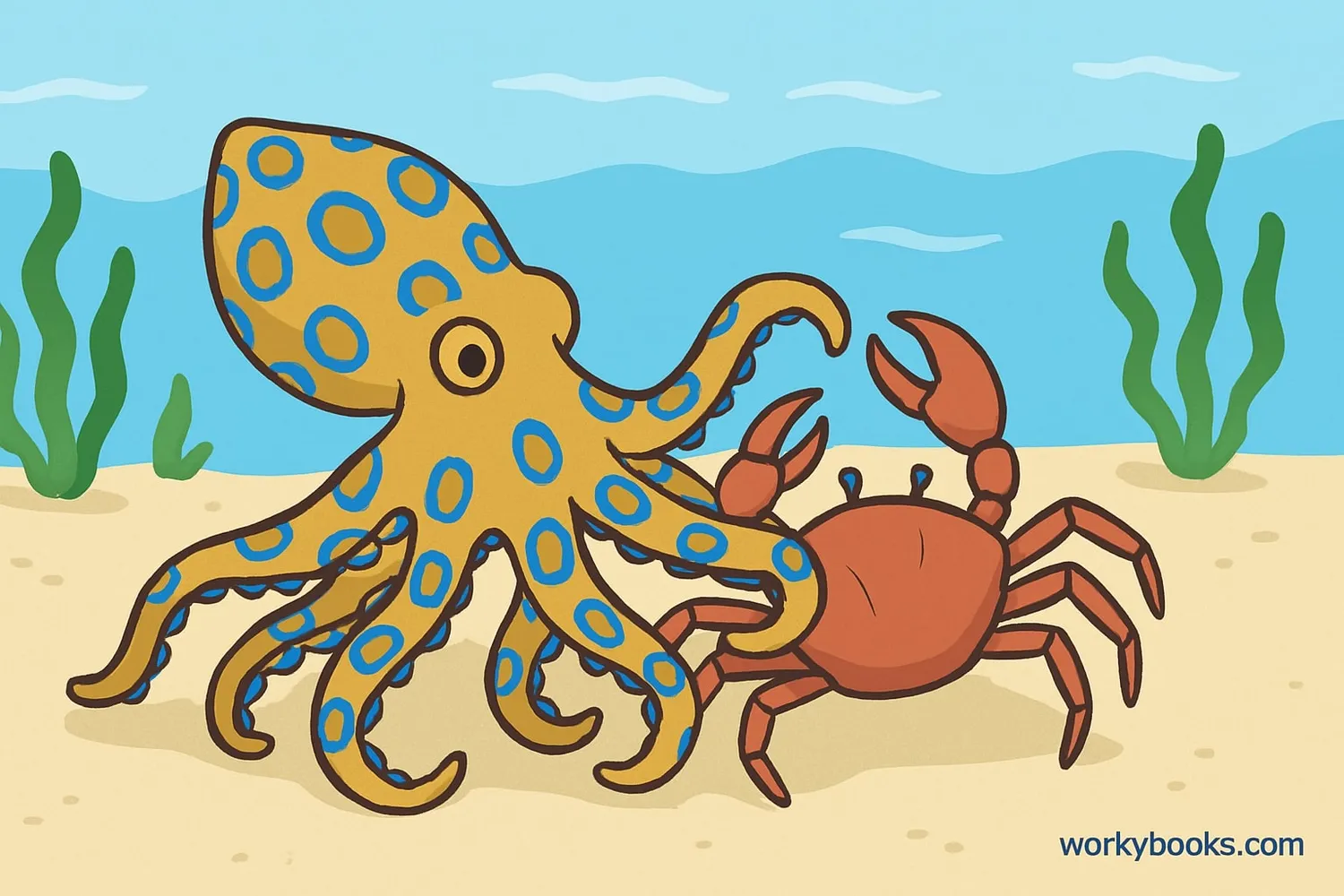Blue-Ringed Octopus - Definition, Examples, Quiz, FAQ, Trivia
Discover one of the ocean's most fascinating and venomous creatures!
What is a Blue-Ringed Octopus?

The blue-ringed octopus is a small but fascinating creature found in the Pacific and Indian Oceans. Despite its small size (about the size of a golf ball when resting), it's one of the most venomous marine animals in the world.
These octopuses get their name from the bright blue rings that appear on their bodies when they feel threatened. When calm, their skin is a sandy yellow or brown color that helps them blend into their surroundings. There are three main species: the Greater blue-ringed octopus, the Southern blue-ringed octopus, and the Blue-lined octopus.
Blue-ringed octopuses belong to the genus Hapalochlaena and are known for their intelligence and unique hunting methods. They have a soft body, eight arms, and excellent eyesight. Unlike many other octopuses, they spend most of their time crawling along the ocean floor rather than swimming.
Octopus Fact!
Blue-ringed octopuses are only about 12-20 cm (5-8 inches) long when fully grown, but their venom is powerful enough to paralyze humans!
Habitat and Distribution

Blue-ringed octopuses are found in warm, shallow waters of the Pacific and Indian Oceans. They prefer habitats with plenty of hiding spots where they can stay camouflaged during the day.
You might find them in:
• Tide pools - Shallow pools of seawater left when the tide goes out
• Coral reefs - Colorful underwater ecosystems made of coral
• Rocky shores - Areas with lots of rocks and crevices
• Sandy bottoms - Ocean floors covered with sand
These octopuses are most commonly found around Australia, but they also live near Japan, the Philippines, and other coastal areas of the Pacific and Indian Oceans. They spend most of their time hiding in crevices, empty shells, or buried in sand during the day and come out to hunt at night.
Location
Pacific and Indian Oceans, especially around Australia
Habitat
Shallow waters, tide pools, coral reefs, and rocky shores
Behavior
Nocturnal hunters that hide during the day
Venom and Hunting

The blue-ringed octopus has one of nature's most powerful venoms - tetrodotoxin. This neurotoxin is 1,000 times more powerful than cyanide and can paralyze its prey within seconds.
How they hunt:
1. They wait patiently for prey like crabs or shrimp
2. When close enough, they bite through the shell
3. Venom paralyzes the prey immediately
4. They use their beak to break apart the prey
5. Digestive enzymes turn the prey's insides to liquid
6. They suck out the nutrients
Their venom contains tetrodotoxin (TTX), the same poison found in pufferfish. A single octopus carries enough venom to kill 26 adult humans! The venom works by blocking nerve signals, causing paralysis. Despite this danger, blue-ringed octopuses are not aggressive and only bite when threatened.
Venom Fact!
There is no known antivenom for blue-ringed octopus bites. Immediate medical attention is crucial for survival!
Danger to Humans

While beautiful to look at, blue-ringed octopuses are extremely dangerous to humans. Their bites are usually painless, so people might not even realize they've been bitten until symptoms appear.
Symptoms of a bite:
• Numbness around the mouth
• Difficulty breathing and swallowing
• Nausea and vomiting
• Muscle weakness and paralysis
• Loss of consciousness
If someone is bitten:
1. Call emergency services immediately
2. Apply pressure to the wound
3. Perform rescue breathing if needed
4. Keep the person calm and still
Remember: Never touch or handle a blue-ringed octopus! They only bite when threatened, so the best protection is to admire them from a distance. Always watch where you step in tide pools and wear protective footwear.
Blue-Ringed Octopus Quiz
Test your knowledge about blue-ringed octopuses with this quiz! Answer all 5 questions to see how much you've learned.
Frequently Asked Questions
Here are answers to some common questions about blue-ringed octopuses:
Fun Blue-Ringed Octopus Trivia
Discover some amazing facts about blue-ringed octopuses!
Tiny But Mighty
Despite being small enough to fit in the palm of your hand, a blue-ringed octopus carries enough venom to kill 26 adult humans within minutes!
Clever Hunters
Blue-ringed octopuses are highly intelligent. They can solve puzzles, remember solutions, and even use tools like coconut shells for shelter!
Master of Disguise
When not displaying its blue rings, a blue-ringed octopus can change its color and texture to perfectly match its surroundings, becoming almost invisible!
Dedicated Mothers
Female blue-ringed octopuses lay about 50-100 eggs and guard them constantly for about 50 days without eating. They die shortly after the eggs hatch.


